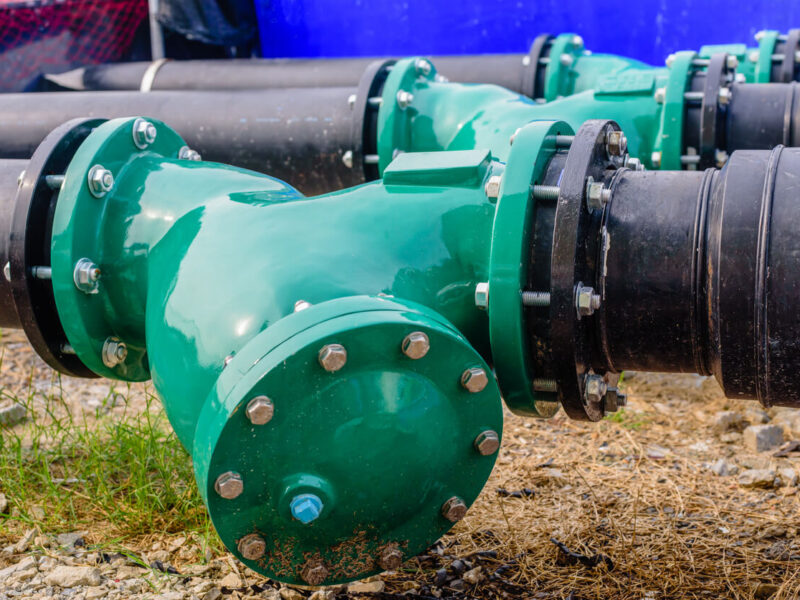
What is a Pipe Strainer?
Filters are mechanical devices that trap (and remove) unwanted particles from flowing liquids while protecting equipment such as pumps and compressors. Filters are classified into three types: Y, basket, and duplex. The strainer’s screen, notably its mesh size, is an essential component (perforation density).
Pipe Strainers: How Do They Work?
The working principle of the pipeline strainer is straightforward. It doesn’t matter if you use a tee, a simple duplex, or a Y strainer. It would be best if you recognized both the inlet and the outlet. Once the filter is fully seated, fluid flows through the filter housing into the intake segment. As the fluid flows, the filter captures and holds all foreign matter. This can include algae, plastics, large particles, etc. Well-functioning filters successfully block foreign particles.
Additionally, the filter may have many components. Each of these components plays a particular part in the process. For example, there are two sides of the pipe strainer; one is the suction side, and the other is the discharge side.
Briefly, the pipeline filter theory of operation includes the following basic steps:
- The liquid passes from Intel into the basket filter.
- Basket strainer traps soil, debris, and particles.
- Once locked, the pressure differential will activate the warning.
- Depending on the filter configuration, it is possible to stop the hose mechanism or to guide the flow to the next basket filter. It is not a complicated operation.
Pipe Strainers are classified into Y and T strainers.
Y Strainer
A Y-strainer is a small Y-shaped tool that traps undesirable particles in pipes. Y filters can be positioned horizontally or vertically, with the filter element facing the ground, and cause a pressure drop in the pipeline.
This pipeline strainer must be cleaned regularly to ensure that dirt does not block the device’s filtering. When y-strainers need to be cleaned, the tubing can be kept in service.
Y filters are suitable for high-pressure gas lines with a low concentration of unwanted particles and dirt. Y filters have a smaller dirt-holding capacity than similar-sized T filters.
T Strainer
A basket strainer is an excellent perforated basket that collects dust and objects carried by the Fluid conveyed by the pipeline. Due to the larger size of the filter element, a basket filter can store more dust and dirt than a basket filter and a Y-strainer of the same size and is the preferred choice when line pressure drops are unacceptable. Filters should be placed upright, with the top removed for periodic cleaning.
The well-known “duplex basket filter” is a form of T-filter comprising two parallel T-filters which facilitate filtration maintenance of the element by keeping the line operational.
Y-Strainer Mesh
Y-strainer mesh size is a critical consideration. The mesh indicates the number of holes per inch in the screen, which is the filter element. Screen mesh size can be specified in millimeters, inches, microns, or mesh numbers.
The following factors should be considered when determining the appropriate mesh:
- The largest particle size that downstream equipment can safely handle.
- Piping system operating temperature and pressure
- Maximum pressure drop allowed.
- The type of fluid transmitted.
If the mesh is too small, some unwanted particles can pass through and damage downstream equipment. In addition, extra amounts of dirt may accumulate in the strainer cage, causing pressure decreases in the pipe system and higher-than-necessary maintenance costs.
Materials used to make the different parts of the strainers:
Housing Materials
Cast iron, bronze, carbon steel, stainless steel, and plastic are the most prevalent materials used for the bodies of Y and basket strainers. Y-strainers have bodies constructed from the same cast and forged materials as other commercial valves.
Cast Iron
Cast iron is the most popular filter housing material due to its low initial cost. It is used in systems where the pressure and temperature of the water are not excessive and where the system is not subjected to numerous thermal or mechanical shocks.
Cast iron is primarily used for more extensive potable water lines, various non-potable water systems, and various other products and process applications.
Bronze
A bronze body is ideal for brackish, saline, and marine service. In addition, it is frequently used to provide potable water services. However, it costs twice as much as cast iron.
Carbon Steel
Carbon steel bodies are utilized in high-temperature and pressure applications and when thermal and mechanical stress resistance is required. Carbon steel is also used in settings with a fire risk.
Chromium-Molybdenum Alloy
Elevated pressures and temperatures above 1000°F are typically specified for Chromium-Molybdenum steel bodies.
Stainless Steel
Because of its corrosion, contamination resistance, and convenience of cleaning, stainless steel is ideal for the body, basket, and screen in the pharmaceutical, food, and chemical industries. In addition, stainless steel is around four times the price of cast iron.
Cast steel and forged steel are the most commonly used material grades for strainer bodies.
In the market for high-quality pipe strainers, BCST is the brand to consider. Considering their durability, variety of benefits, and affordability, they are an excellent choice for anyone needing a pipe strainer. A leading manufacturer of pipe strainers in China, BCST is one of the most trusted companies in the industry.
Our company can be reached at [email protected] or through our website at www.bcstgroup.com.






